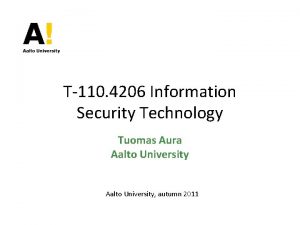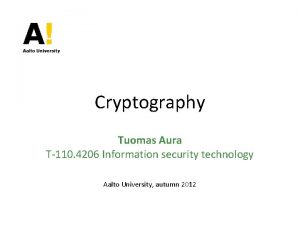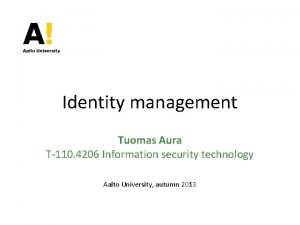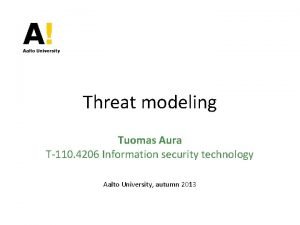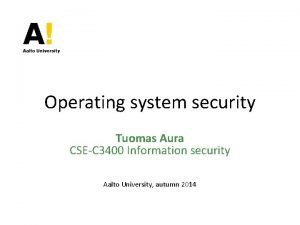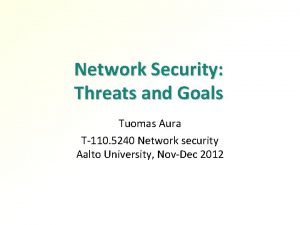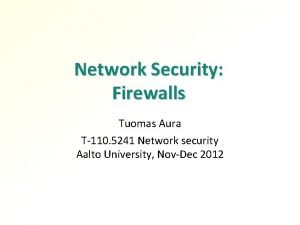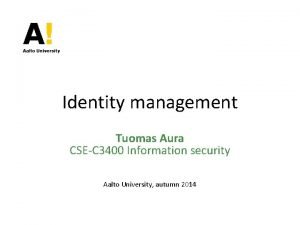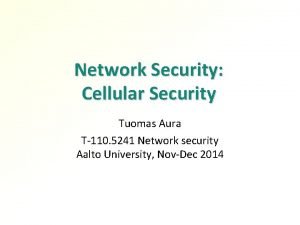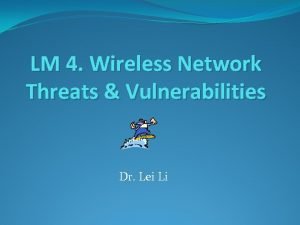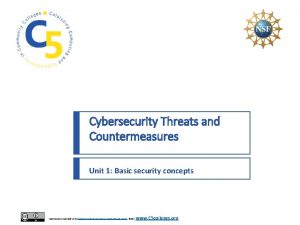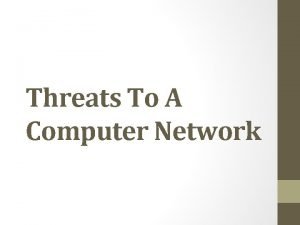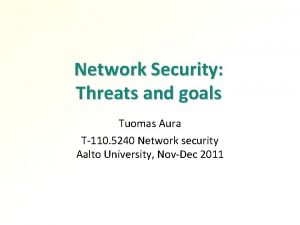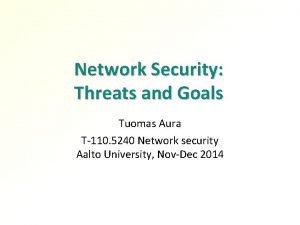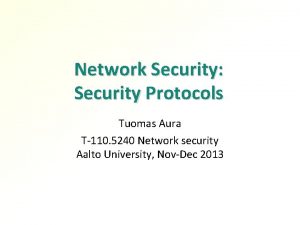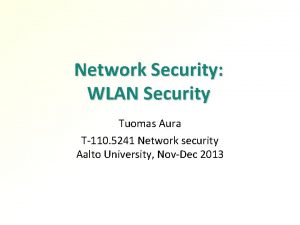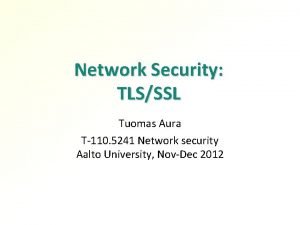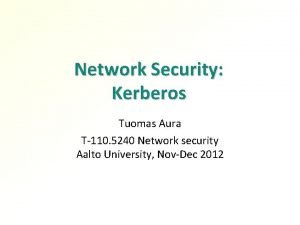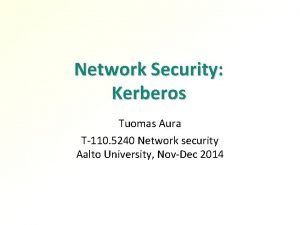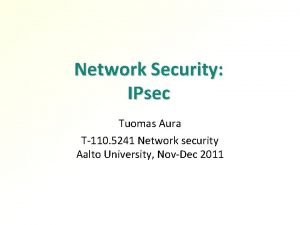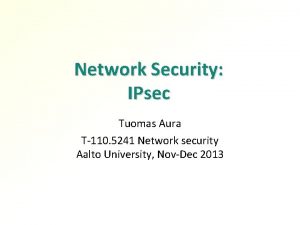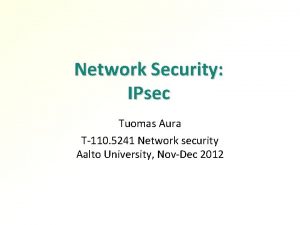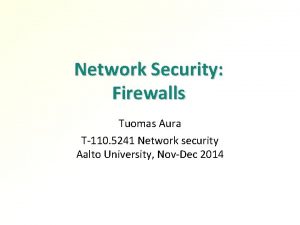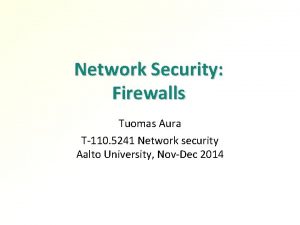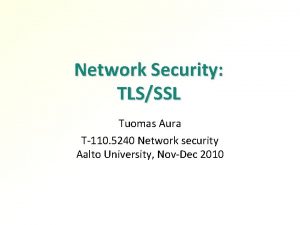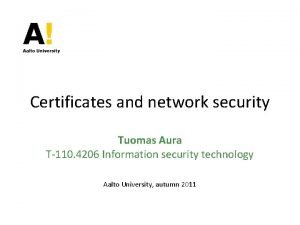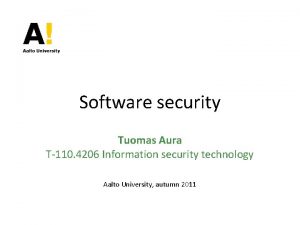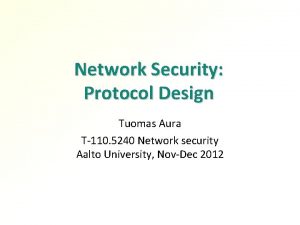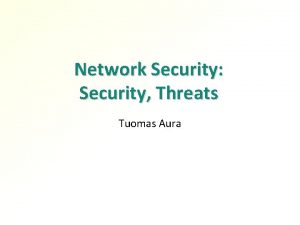Network Security Threats and Goals Tuomas Aura T110





























- Slides: 29

Network Security: Threats and Goals Tuomas Aura T-110. 5240 Network security Aalto University, Nov-Dec 2012

Outline 1. 2. 3. 4. 5. Network security Basic network threats: sniffing and spoofing Role of cryptography Security and the network protocol stack Case study: email security 2

Network security 3

What is network security Network security protects against intentional bad things done to communication Protect messages (data on wire) and communication infrastructure Network security goals: Confidentiality — no sniffing Authentication and integrity — no spoofing of data or signaling, no man-in-the-middle attacks Access control — no unauthorized use of network Availability — no denial of service by preventing communication Privacy — no traffic analysis or location tracking

Who is the attacker? We partition the world into the good and bad side Honest parties vs. attackers Good entities follow specification, bad ones do not Different partitions lead to different perspectives on the security of the same system Typical attackers: Curious or dishonest individuals — for personal gain Hackers, crackers, script kiddies — for challenge and reputation Political activists — for political pressure Companies — for business intelligence and marketing Security agencies — NSA, SVR, GCHQ, DGSE, etc. Military SIGINT — strategic and tactical intelligence, cyber-war Organized criminals — for money Often, not all types of attackers matter to everyone E. g. would you care if NSA/university/mom read your email? 6

Basic network threats: sniffing and spoofing 7

Traditional network-security threat model Me ss ag es Network = Attacker s Me ge a s s End are nodes trusted, the network is unreliable End nodes send messages to the network and receive messages from it Network will deliver some messages but it can read, delete, modify and replay them Metaphors: unreliable postman, notice board, rubbish basket 8

Basic network security threats Traditional major threats: Sniffing = attacker listens to network traffic Spoofing = attacker sends unauthentic messages Data modification (man in the middle) = attacker intercepts and modifies data Corresponding security requirements: Data confidentiality Data-origin authentication and data integrity 10

Man in the middle (Mit. M) In the man-in-the-middle attack, the attacker is between the honest endpoints Attacker can intercept and modify data → combines sniffing and spoofing On the Internet, a Mit. M attacker must be at the local network of one of the end points be at a link or router on the route between them, or change routing to redirect the packets via its own location Note: Just forwarding data between two endpoints (like a piece of wire) is not an attack. What does the attacker gain? 18

Other network threats What other threats and security requirements are there on open networks? Other threats: Unauthorized resource use (vs. access control) Integrity of signalling and communications metadata Denial of service (Do. S) (vs. availability) Traffic analysis, location tracking Lack of privacy Software security Not captured well by the traditional networksecurity model 19

Role of cryptography 20

Cryptographic primitives Symmetric (shared-key) encryption for data confidentiality Block and stream ciphers, e. g. AES-CBC, RC 4 Cryptographic hash function E. g. SHA-1, SHA 256 Message authentication code (MAC) for data authentication and integrity E. g. HMAC-SHA-1 Public-key (or asymmetric) encryption E. g. RSA, El. Gamal Public-key signatures E. g. RSA, DSA Diffie-Hellman key exchange Random number generation

Crypto Wars – some history Until ‘ 70 s, encryption was military technology In ‘ 70 s and ‘ 80 s, limited commercial applications American export restrictions and active discouragement prevented wide commercial and private use Reasons to ban strong encryption: Intelligence agencies (e. g. NSA) cannot spy on encrypted international communications Criminals, terrorists and immoral people use encryption In ‘ 90 s: PGP, SSL, SSH and other commercial and opensource cryptography became widely available Activists argued that cryptography was a tool for freedom Researchers argued that weak crypto is like no crypto Encryption became necessary for business on the Internet Most export restrictions were lifted in 2000 22

Security and the network protocol stack 25

Protocol Stack and Security Application E. g. email: PGP, S/MIME Middleware E. g. XML Encryption TCP, UDP, . . . (transport) IP (network) Ethernet protocol Physical network TLS/SSL, SSH IPSec 802. 1 X, WEP Security solutions exist for every protocol layer Layers have different security and performance tradeoffs, trust relations and endpoint identifiers 26

End-to-end security Security should be implemented between the endpoints of communication. All intermediaries are part of the untrusted network End-to-end security only depends on the end nodes Hop-by-hop (link-layer) security assumes all routers are trusted and secure End-to-end security protocols are independent of the network technology at intermediate links Link-layer security is different for each link type Confidentiality and authentication are usually user or application requirements Network or link layer only cannot know application-level requirements But link and network layer infrastructure and signalling need protection, too 28

Endpoint names Authentication and integrity depend on names (identifiers) Each protocol layer has its own way of naming endpoints: Ethernet (MAC) addresses in the link layer (e. g. 00 -B 0 -D 0 -05 -04 -7 E) IP address in the network layer (e. g. 157. 58. 56. 101) TCP port number + IP address DNS or Net. BIOS name in the higher layers (e. g. vipunen. tkk. fi) URI in web pages and services (e. g. http: //www. example. org/myservice) 29

Email security

Security requirements What kind of security is needed for email? Confidentiality? Authentication? Non-repudiation? PGP, S/MIME Time stamping? Mandatory access control, DRM? Spam control? Phishing prevention? Anonymity? We use email security as the first example because it is a fairly straightforward application of crypto and allows us to introduce many basic concepts Crypto does not solve all email security problems 32

Internet email architecture Alice sends mail to bob@contoso. com Where are the security vulnerabilities? 33

Pretty Good Privacy (PGP) Extra reading material 34

Sign, compress, encrypt Sender and receiver need to know each other’s public keys Options to encrypt only or to sign only: Possible to sign without knowing receiver’s public key, or when sending to a mailing list Possible to encrypt without identifying sender 35

Example: PGP-encrypted message -----BEGIN PGP MESSAGE----Version: Gnu. PG v 1. 4. 8 Comment: Encrypted secret message. h. QEOA 1 e+1 x 6 Yu. UMCEAQAo. ST 1 l/obn. XOB 6 fh. Ihm. Ln. GVLhuxmsks. KD+Efyk 7 ja 9 g. Ox U 5 X 98/25 ZVDQz 0 Ei. Ok. Rj. W 2 LChu. Zt 9 Kesh 1 DSIRw. B/ll. XCm 3 pb. NX/V+ajk. L 4 Fzxlw j. WCCedv 527 SUNTUP 70 lh. Lbh 4 O 2 k. HHx. Md. En 41 z. Vo 9 TPUgt. Q 1 BIo 32 k/x. P 2 RYt. PCEE AJDhcyp+COLa. I 4 idibf. Sr. DDt. Yc. T+h. VVFVve. Ite. TIczno. Uo. S 1 y. Vyip. E 4 m. Bwa 380 c 6 Tiw. Imq 63 h. Ohs 62 c 9 BOQv 7 G 9 cnaq. EZNg 0 n. Li. VZD+K/Je. N 00 z. ILm+Tzd. WZxr. W 019 n. A +ts. Mwzn. UZ 2 V/k. QZj. S 9 xk. PWjn 7 Zz. PTy. W 6 g. Lhj. WQNlr 93 S 0 lc. BT 0 CJy 285 ix. Fz 9 Ur. J qj. K 2 azs. Bd. XRc. Vu. XFdh 84 LW 1 E/8/8 Dwd. Lg. SK 9 X/j. PNv 3/WGLA 4 Ez 2 x. TFIUor. Vi 5 Xe M 9 dpri. EQ 0 Jg 2 msnz 2 bjq. RGZli. XXo 6 m 8 ye/A= =YWDi -----END PGP MESSAGE----- “Meet me in the park at 6 PM. ” 37

ASCII armor headers for sending in text email PK-encrypted session key EB(SK) (may repeat for multiple recipients) For quick check of successful decryption Unix time (seconds since 1 Jan 1970 UTC) For quick check of the hash Encrypted Message ESK(…) ASCII armor checksum Typical PGP message -----BEGIN PGP MESSAGE----Version: Gnu. PG v 1. 4. 8 Recipient key id Session key SK EB Random block (IV) + 2 repeating bytes Signature type Signing time Signer key id 2 bytes of hash RSA/DSA signature Radix-64 Hash &Sign. A Zip ESK Data =oj. UK -----END PGP MESSAGE----- 38

Radix-64 encoding Use safe ASCII characters to represent values 0. . 63: ABCDEFGHIJKLMNOPQRSTUVWXYZabcdefghijklmnopqrstuv xyz 0123456789+/ Encode each 3 bytes as 4 characters: +--first octet--+-second octet--+--third octet--+ |7 6 5 4 3 2 1 0|7 6 5 4 3 2 1 0| +------+-------+---+------+ |5 4 3 2 1 0|5 4 3 2 1 0| +--1. char---+--2. char---+--3. cahr---+--4. char---+ If the data length is not divisible by 3, pad with one or two = characters to indicate actual length 41

S/MIME PGP is mainly used by private persons and academia S/MIME is a similar standard used primarily by enterprises, e. g. Outlook Message structure based on the MIME standards Envelopes and signatures are new MIME types → Base 64 encoding 42

Non-repudiation Proof of authenticity to third parties Email sender cannot later deny sending the message (i. e. cannot repudiate the message) Third party, such as a judge, is needed to make the decision The public key must be somehow registered to bind it to the person signing Uses: Accountability for sent messages Contract signing Questions: Does the sender of an email want to go do extra work in order to be accountable for the emails he sends? → Little motivation to sign messages Are business contracts signed using secure email? 43

Related reading William Stallings, Network security essentials: applications and standards, 3 rd ed. : chapter 1 William Stallings, Cryptography and Network Security, 4 th ed. : chapter 1 Dieter Gollmann, Computer Security, 2 nd ed. chapter 13; 3 rd ed. chapters 16. 1, 17. 1 Ross Anderson, Security Engineering, 2 nd ed. : chapter 6 45

Exercises Design a more spoofing-resistant acknowledgement scheme to replace TCP sequence numbers. Hint: use random numbers (and maybe hashes) to ensure that acknowledgements can only be sent by someone who has really seen the packets Which applications of hash functions in network protocols require strong collision resistance? Which do not? Why is link-layer security needed e. g. in WLAN or cellular networks, or is it? To what extent are the identifiers in each protocol layer of the TCP/IP stack unique? Does one layer in the protocol stack know the identifiers of other layers? How do the properties of these identifiers differ: IP address, DNS name, email address, person’s name, company name, national identity number (HETU) How to prevent SMTP spoofing without end-to-end cryptography? What can be filtered at SMTP servers and what cannot? Does signing of emails help spam control? Install an Open. PGP implementation (e. g. GPG). How do you check that the binary or source code has not been tampered with? Would you use PGP itself to verify the signature or fingerprint on the installation package? 46
 Tuomas aura
Tuomas aura Tuomas aura
Tuomas aura Tuomas aura
Tuomas aura Tuomas aura
Tuomas aura Tuomas aura
Tuomas aura Tuomas aura
Tuomas aura Tuomas aura
Tuomas aura Tupas finland
Tupas finland Trust key t110
Trust key t110 Tuomas aura
Tuomas aura Syncope vs seizure
Syncope vs seizure Modern network security threats
Modern network security threats Strategic goals tactical goals operational goals
Strategic goals tactical goals operational goals Strategic goals tactical goals operational goals
Strategic goals tactical goals operational goals Wireless security threats and vulnerabilities
Wireless security threats and vulnerabilities Cyber security threats and countermeasures
Cyber security threats and countermeasures Wireless security in cryptography and network security
Wireless security in cryptography and network security Ecommerce security threats
Ecommerce security threats Wireless security threats
Wireless security threats Most common computer security threats
Most common computer security threats Private secruity
Private secruity Osi security architecture model with neat diagram
Osi security architecture model with neat diagram Security guide to network security fundamentals
Security guide to network security fundamentals Electronic mail security in network security
Electronic mail security in network security Security guide to network security fundamentals
Security guide to network security fundamentals Security guide to network security fundamentals
Security guide to network security fundamentals General goals and specific goals
General goals and specific goals Motivation in consumer behaviour
Motivation in consumer behaviour Physical security goals and objectives
Physical security goals and objectives Tuomas hulkkonen
Tuomas hulkkonen
